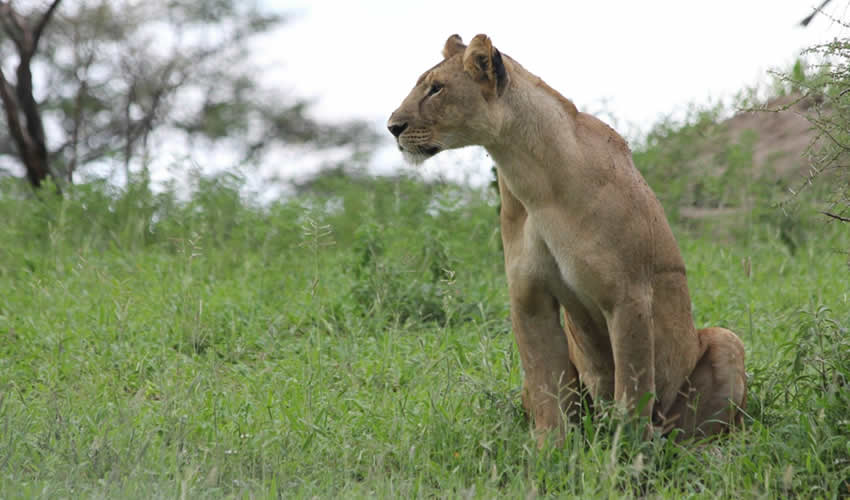Visit Tanzania with Gorilla Adventure Tours and make the most of your stay on this 9 Days Tanzania Wildlife Safari. You will get to visit Arusha, Tarangire, Ngorongoro, Manyara, Serengeti and encounter plenty of wildlife species. Enquire Now Contact us to book this tour.

Detailed Itinerary.
Day 1: Arrival – Arusha.
Upon arrival to Arusha, you will be welcomed by our company representative in the public waiting area of the Airport after passing through baggage claim. This guide will transfer you to your hotel and assist with check-in. Before departing on your first day of activities, a trip representative will meet you at your hotel to discuss the details of your trips and answer any questions you may have. This marks the start of the 9 Days Tanzania Wildlife Safari.
Day 2: Arusha – Transfer to Tarangire.
From Arusha, your guide will drive you to the Tarangire National Park. Approximate travel time is three hours.
On this afternoon’s game drive you will notice the unusually shaped baobab trees, also known as the “upside-down tree”. Look up and you might find the tree climbing African pythons. This is one of the world’s largest species of snakes, but do not worry, it is also a non-venomous species. Tarangire’s pythons climb trees, as do its lions and leopards, lounging in the branches.
Day 3: Tarangire.
The sun-kissed plains of Tarangire National Park are home to an incredible range of wildlife. Herds of elephants, prides of lions, troops of baboons, towers of giraffes and many more impressive creatures dot the land, as the park’s lagoons and rivers lure animals with reliable, life-sustaining sources of water. Surrounding the swamps – tinged green year-round – a remarkable array of bird-life can be found, more than 500 species visit these lands. Today, reveal the wonders of Tarangire National Park alongside an expert guide, enjoying a boxed lunch mid-day to ensure you have the energy needed to fully appreciate this brilliant park.
Day 4: Tarangire – Ngorongoro – Manyara.
Your guide will pick you up at your lodge in Tarangire and transport you to your lodge in Ngorongoro, stopping along the way for a fascinating game drive at Lake Manyara National Park.
Best known for its baboon population, the Manyara region is a land of sweeping plains, giant figs and mahogany trees, and is host to a range of herbivores including hippos, impalas, elephants, wildebeests, buffalo, warthogs and giraffes. The scenic Lake Manyara National Park has the wall of the Great Rift Valley to one side and the lake on the other, and affords guests with incredible photography opportunities. Today you will explore this diverse land on a game drive alongside an expert guide. Lucky guests may spot the rare tree climbing lion while in Manyara, and following your exploration, you will be transferred to your lodge or camp.
Day 5: Ngorongoro.
Today, discover one of the most remarkable wildlife conservation areas in Tanzania; the Ngorongoro Crater. Departing from your camp in a privately driven vehicle alongside a local expert guide, make your way to the entrance of the park, then drive a further 20 minutes to reach the rim of Ngorongoro Crater: the world’s largest inactive, intact, and unfilled volcanic caldera. This geological marvel was formed as the result of a gigantic explosion which caused the volcano to collapse on itself, thereby creating the massive crater. Roughly 12 miles wide and some 2,000 feet deep, the trip from crater rim to floor takes approximately 45 minutes by vehicle. The extremely fertile crater floor has attracted incredibly dense populations of wildlife, and at present over 25,000 large animals call the crater home, including some of the world’s last remaining black rhinos. The crater floor is also host to some of the highest concentrations of carnivores in the world, featuring large prides of lions, packs of hyenas and solitary predators like cheetahs and jackals. A keen eye paired with expertly procured search patterns from your guide is sure to help you spot a wide range of wildlife and perhaps some of the more elusive species like leopards, servals, and bat-eared foxes. An experienced tracker-guide and private vehicle will accompany you today while exploring Ngorongoro National Park.
Day 6: Ngorongoro – Manyara – Serengeti.
A representative from your lodge will provide you with a transfer to the Manyara airstrip. The transfer time will take approximately 45 minutes to an hour depending on the location of your camp. Board a flight in Manyara with service to the Serengeti. Approximate time will vary based on your arrival airstrip, however, most flights take roughly one hour. Get ready for an afternoon to remember as you set out in the company of an experienced tracker-guide to explore the expanses of the Serengeti. The park is world renowned for its healthy populations of resident wildlife species, in particular the African Big Five consisting of buffaloes, elephants, rhinoceroses, leopards and lions. Although sightings are considered a rarity, a small group of black rhinoceros also live within the park grounds. Heavy concentrations of topi, gazelle, waterbuck and Coke’s hartebeest ensure that local carnivores including cheetah, hyenas and African wild dog are ever present. The park is also home to more than 500 species of birds, including ostriches, crowned cranes, marabou storks and secretary birds; some of the most sought-after and photogenic birds on the planet.
Day 7: Serengeti.
Board a safari vehicle and set out on a captivating game drive. During the morning hours, many animals are just beginning their daily activities and this provides for outstanding viewing and photography opportunities. Typically departing close to the crack of dawn, at roughly 6:30 am, this morning you will head out into the plains of the Serengeti to explore its vast and impressive plains, returning to your lodge just before lunch with stories to share over a delicious meal. The Serengeti was once known as Masai land, and was home to fierce warriors who lived alongside wild animals, surviving off the natural resources of the land. Many of these people can still be found in the region today, some living as far away as the Masai Mara in Kenya. During your safari, consider taking the time to meet the people of an enduring Masai tribe (please speak to your Destination Expert for more information). Whether or not you make the trip to a Masai village, keep in mind as you explore the Serengeti that these lands have been central to Masai life for centuries. As you pass through the region – a photographer’s delight – remind yourself of the incredible, generational history of the Masai people, and the impressive feat of survival on the plains.
Day 8: Serengeti
Today you’ll set out early on a morning game drive with an expert guide. The Serengeti houses an abundance of wildlife. It is home to the millions of wildebeest, Thomson’s gazelle and zebras between August and late October. Another great time to visit the Serengeti is between December and March as the plains are green and lush after the short rains in November, and the animals are well fed and prepared for the calving season in February. At this time, the wildebeest migration is typically occurring in the southern plains of the Serengeti, where young cubs and calves can be spotted. Big game such as lions, leopards, cheetahs, buffaloes, and elephants, as well as giraffes, impalas, gazelles, and zebras are abundant and can be spotted on safari in the Serengeti year-round.
Spend the day taking in the spectacle of one of the top safari highlights of any African sojourn; the famous wildebeest migration. Moving in a clockwise direction throughout the year in the Serengeti ecosystem, the wildebeest then head north into the Masai Mara in Kenya beginning in June and July through to September and October. Sightings cannot be guaranteed as the herds move according to the availability of food sources, thereby making migration movements unpredictable. The herds are accompanied by zebras and Thomson’s gazelles and are stealthily hunted by predators such as leopards, lions and hyenas, bringing into sharp focus the awe-inspiring beauty of nature along with the harsh realities of life on the plains.
Day 9: Serengeti – Arusha.
A representative from your lodge will pick you up and transfer you between the lodge and airstrip. Depending on time, they will fit in a quick game drive to/from the lodge. Board a flight in Serengeti with service to Arusha. The flight will make several stops along on the way. Approximate travel time is two hours.
End of the 9 Days Tanzania Wildlife Safari.
